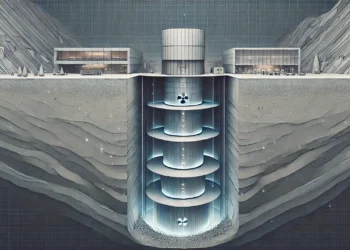
At a former nuclear weapons site in South Carolina, workers recently found a wasp nest contaminated with high levels of radiation near an underground waste tank.
The discovery was made on July 3 at the Savannah River Site, a Cold War-era facility now focused on nuclear cleanup. The nest was located near Tank 17, in a secured part of the site known as 241-127F. At first glance, it looked like any other nest. But when radiation control staff tested it, they found contamination levels ten times higher than what federal safety rules allow — about 100,000 disintegrations per minute per 100 square centimeters.
A Nest of the Nuclear Past
The Savannah River Site (SRS), built in the early 1950s, was once one of the most secretive and strategically important sites in the United States. Here, the government manufactured plutonium pits, the dense cores used to trigger nuclear explosions, as the U.S. and the Soviet Union engaged in a decades-long arms race.
But after the Cold War cooled, SRS now focuses on cleaning up its radioactive legacy, including more than 165 million gallons of liquid nuclear waste generated during weapons production. The facility has reduced the waste, mostly stored in massive underground tanks, to about 34 million gallons, which remain in 43 active tanks.
The discovery of the contaminated wasp nest, however, has rattled some of the watchdogs who monitor the site.
Tom Clements, director of the nonprofit Savannah River Site Watch, is demanding answers. “I’m as mad as a hornet that SRS didn’t explain where the radioactive waste came from or if there is some kind of leak from the waste tanks that the public should be aware of,” he told CBS News.
The Mystery of the Nest

According to the official Department of Energy Occurrence Report, the nest was removed, bagged, and disposed of as radioactive waste. Workers sprayed it with insecticide, and no live wasps were present. The surrounding area showed no signs of contamination, and operations at the facility continued uninterrupted.
Federal officials emphasized that this was not an active leak but a case of “onsite legacy radioactive contamination.” In plainer terms, residual radiation from decades of nuclear activity may have contaminated the environment in ways not fully understood.
Still, Clements says that’s not good enough.
He argues that identifying the type of wasp nest is crucial. “Some wasps make nests out of dirt and others use different material which could pinpoint where the contamination came from,” he wrote in a message. The material might have come from the soil, the surrounding structure, or even contaminated equipment.
Moreover, wasps don’t stray far from home. They typically build their nests just a few hundred yards from their foraging grounds. This means the source of the contamination is likely very close to the tank — and if this nest exists, others could, too.
A statement from Savannah River Mission Completion, the company now managing the site, tried to reassure the public. The tank farm is far from the site’s boundaries, they said, and the nest posed no risk to areas outside the facility.
If any live wasps had been present, officials added, their own radiation levels would have been much lower than the nest’s — suggesting that the insects themselves do not become dangerously radioactive. That’s fortunate. But the presence of such a highly contaminated object in a supposedly safe area has raised uncomfortable questions.
What Could Have Caused This?
The exact pathway through which the nest became contaminated remains unknown, and explanations so far are unconvincing. The official report offers no clear origin, only that this is a case of “legacy contamination.”
Legacy contamination is a nuclear oversight term referring to leftover radioactive material from past activities that has not been actively released but still lingers in the environment. But without more detail, some experts say the term can act as a bureaucratic shield.
“No further action was required in the field,” the report concludes. That decision, while seemingly justified by the lack of immediate threat, leaves Clements and others uneasy. If radioactive material can wind up in a wasp nest, it raises a broader question: What else is out there, quietly collecting radiation?
But contaminated wildlife has appeared at nuclear sites before. Birds, insects, and even rodents have occasionally triggered alarms after coming into contact with contaminated areas. But the Savannah River discovery is notable both for the intensity of the contamination and the lack of explanation about its source.
The site has previously documented similar wildlife contamination events — so much so that the delay in filing the report, according to the DOE, was due to staff reviewing earlier occurrences “for consistency in reporting criteria.”
Insects and Isotopes
For now, there are no mutant wasps, no leaking tanks, and no immediate public threat. The incident, while unusual, is not unprecedented.
Still, as one of the last vestiges of the Cold War cleanup effort, the Savannah River Site holds a unique place in America’s nuclear history—and its nuclear future.






